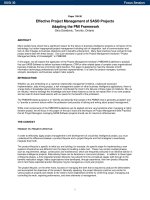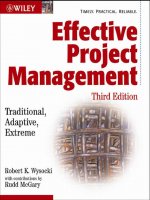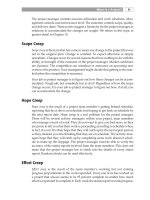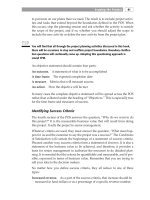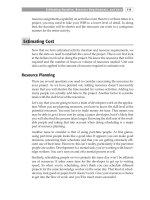Effective project management traditional, agile, extreme 5th ed
Bạn đang xem bản rút gọn của tài liệu. Xem và tải ngay bản đầy đủ của tài liệu tại đây (4.61 MB, 796 trang )
technique. All of this will give you a complete understanding of how to successfully complete
projects on time and within budget.
This comprehensive guide shows you how to:
• Apply all nine Knowledge Areas dened
in PMBOK
Kđ
ã Establish project management life cycles
and strategies
ã Decide the best method for managing
specific types of projects
• Select and use best-of-breed project
management tools and templates for
each management task
• Utilize the Project Support Office, Project
Portfolio Management, and Continuous
Process Improvement programs
• Prevent projects from becoming distressed
and create effective intervention
strategies
• Manage multiple team projects by integrating
the tools, templates, and processes into a
single team
Robert K. Wysocki, PhD, has over 40 years of experience
e as a project management consultant and trainer, information
systems manager, systems and management consultan
nt, author, training developer, and provider. He is the founder
of Enterprise Information Insights, Inc., a project manag
gement consulting and training practice. Wysocki has written
15 books on project management and information systtems management.
Effective Project Management
Get ready for a more robust approach to project management — one that recognizes the
project environment and adapts accordingly. This resource first introduces you to the tools,
templates, and processes that you’ll need in your toolkit. You’ll then explore five different project
management life cycle (PMLC) models for managing a project: Linear, Incremental, Iterative,
Adaptive, and Extreme. Along the way, you’ll find step-by-step guidance on how to apply each
Robert K. Wysocki
Traditional, Agile, Extreme
Gain the skills and tools to become
an effective project manager
Wysocki
Effective
Project
Management
FIFTH EDITION
ISBN: 978-0-470-42367-7
Visit our Web site at www.wiley.com/go/epm5e
Projec
Pro
jjectt Management
g
ent
FIFTH EDITION
5
Effective Project
Management
Effective Project
Management
Traditional, Agile, Extreme
Fifth Edition
Robert K. Wysocki, Ph.D.
Wiley Publishing, Inc.
Effective Project Management: Traditional, Agile, Extreme, Fifth Edition
Published by
Wiley Publishing, Inc.
10475 Crosspoint Boulevard
Indianapolis, IN 46256
www.wiley.com
Copyright © 2009 by Robert K. Wysocki
Published by Wiley Publishing, Inc., Indianapolis, Indiana
Published simultaneously in Canada
ISBN: 978-0-470-42367-7
Manufactured in the United States of America
10 9 8 7 6 5 4 3 2 1
No part of this publication may be reproduced, stored in a retrieval system or transmitted in any form
or by any means, electronic, mechanical, photocopying, recording, scanning or otherwise, except as
permitted under Sections 107 or 108 of the 1976 United States Copyright Act, without either the prior
written permission of the Publisher, or authorization through payment of the appropriate per-copy fee
to the Copyright Clearance Center, 222 Rosewood Drive, Danvers, MA 01923, (978) 750-8400, fax (978)
646-8600. Requests to the Publisher for permission should be addressed to the Permissions Department,
John Wiley & Sons, Inc., 111 River Street, Hoboken, NJ 07030, (201) 748-6011, fax (201) 748-6008, or
online at />Limit of Liability/Disclaimer of Warranty: The publisher and the author make no representations or
warranties with respect to the accuracy or completeness of the contents of this work and specifically
disclaim all warranties, including without limitation warranties of fitness for a particular purpose. No
warranty may be created or extended by sales or promotional materials. The advice and strategies
contained herein may not be suitable for every situation. This work is sold with the understanding
that the publisher is not engaged in rendering legal, accounting, or other professional services. If
professional assistance is required, the services of a competent professional person should be sought.
Neither the publisher nor the author shall be liable for damages arising herefrom. The fact that an
organization or Web site is referred to in this work as a citation and/or a potential source of further
information does not mean that the author or the publisher endorses the information the organization
or Web site may provide or recommendations it may make. Further, readers should be aware that
Internet Web sites listed in this work may have changed or disappeared between when this work was
written and when it is read.
Library of Congress Cataloging-in-Publication Data
Wysocki, Robert K.
Effective project management : traditional, agile, extreme / Robert K. Wysocki. – 5th ed.
p. cm.
Includes bibliographical references and index.
ISBN 978-0-470-42367-7 (paper/website) 1. Project management. I. Title.
HD69.P75W95 2009
658.4 04–dc22
2009001889
For general information on our other products and services please contact our Customer Care
Department within the United States at (877) 762-2974, outside the United States at (317) 572-3993 or
fax (317) 572-4002.
Trademarks: Wiley and the Wiley logo are trademarks or registered trademarks of John Wiley & Sons,
Inc. and/or its affiliates, in the United States and other countries, and may not be used without written
permission. All other trademarks are the property of their respective owners. Wiley Publishing, Inc. is
not associated with any product or vendor mentioned in this book.
Wiley also publishes its books in a variety of electronic formats. Some content that appears in print
may not be available in electronic books.
My mother died before this book was published and I wish to dedicate it
to her. She wasn’t an educated person in the sense of formal education.
She was able to complete only the 8th grade when the Great Depression
brought untold problems on her family. She loved books and knew the
importance of a good education. She gave me that same love of books
and an education. This is my 17th book, and it is to her that I
owe this success.
Wysocki
fauth.tex
V2 - 03/20/2009
3:07pm
About the Author
Robert K. Wysocki, Ph.D., has over 40 years’ experience as a project management consultant and trainer, information systems manager, systems and
management consultant, author, training developer and provider. He has written 16 books on project management and information systems management.
One of his books, Effective Project Management, 4th Edition, has been a best-seller
and is recommended by the Project Management Institute for the library
of every project manager. He has over 30 publications and presentations in
professional and trade journals and has made more than 100 presentations at
professional and trade conferences and meetings. He has developed more than
20 project management courses and trained over 10,000 project managers.
In 1990 he founded Enterprise Information Insights, Inc. (EII), a project management consulting and training practice specializing in project management
methodology design and integration, Project Support Office establishment,
the development of training curriculum, and the development of a portfolio
of assessment tools focused on organizations, project teams, and individuals.
His clients include AT&T, Aetna, Babbage Simmel, British Computer Society,
Boston University Corporate Education Center, Computerworld, Converse
Shoes, the Czechoslovakian Government, Data General, Digital, Eli Lilly, Harvard Community Health Plan, IBM, J. Walter Thompson, Novartis, Peoples
Bank, Sapient, The Limited, The State of Ohio, Travelers Insurance, Wal-Mart,
Wells Fargo, ZTE, and several others.
He is a member of the ProjectWorld Executive Advisory Board, the Project
Management Institute, the American Society of Training and Development, the
International Institute of Business Analysts and the Society of Human Resource
Management. He is past Association Vice President of AITP (formerly DPMA).
He earned a B.A. in mathematics from the University of Dallas, and an M.S.
and Ph.D. in mathematical statistics from Southern Methodist University.
vii
Page vii
Wysocki
fauth.tex
V2 - 03/20/2009
3:07pm
Page viii
Wysocki
fcredit.tex
V2 - 03/23/2009
10:42am
Credits
Executive Editor
Bob Elliott
Senior Development Editor
Kevin Kent
Technical Editor
Brenda Gillingham
Production Editor
Dassi Zeidel
Copy Editor
Kathryn Duggan
Vice President and Executive
Group Publisher
Richard Swadley
Vice President and Executive
Publisher
Barry Pruett
Associate Publisher
Jim Minatel
Project Coordinator, Cover
Lynsey Stanford
Proofreader
Publication Services, Inc.
Editorial Manager
Mary Beth Wakefield
Indexer
Ted Laux
Production Manager
Tim Tate
Cover Designer
Ryan Sneed
ix
Page ix
Wysocki
fcredit.tex
V2 - 03/23/2009
10:42am
Page x
Wysocki
f05.tex
V2 - 03/24/2009
3:24pm
Acknowledgments
This acknowledgment is really my special thanks to the teaching faculty of
at least 100 universities and colleges all over the globe that have adopted
previous editions. Many of them have offered feedback that I find most useful.
Many of their suggestions have been incorporated in this fifth edition. I also
owe a debt of gratitude to the many consultants and companies across the
globe that have used APF and taken the time to comment on their experiences.
I am aware of APF being adopted in several industries including banking,
insurance, film production, retailing, drug research, distribution, professional
services, supply chain management, and logistics. To them I offer my heartfelt
thanks.
Finally, I owe my heartfelt appreciation to Brenda Gillingham. She has
taught from previous editions of this book and is a fulltime consultant at Sun
Microsystems. Her help as technical editor was exemplary.
xi
Page xi
Wysocki
f05.tex
V2 - 03/24/2009
3:24pm
Page xii
Contents
Acknowledgments
Preface to the Fifth Edition
Introduction
xi
xxxix
xli
Part I
Defining and Using Project Management Process Groups
Chapter 1
What Is a Project?
Defining a Project
Sequence of Activities
Unique Activities
Complex Activities
Connected Activities
One Goal
Specified Time
Within Budget
According to Specification
What Is a Program?
Establishing Temporary Program Offices
Establishing Permanent Program Offices
Understanding the Scope Triangle
Scope
Quality
Cost
Time
Resources
Envisioning the Scope Triangle as a System in Balance
Managing the Creeps
Scope Creep
Hope Creep
1
5
6
6
6
7
7
7
7
8
8
8
9
9
9
10
10
10
11
11
12
13
13
14
xiii
xiv
Contents
Effort Creep
Feature Creep
Chapter 2
14
14
Applying the Scope Triangle
Problem Resolution
Scope Change Impact Analysis
The Importance of Classifying Projects
Establishing a Rule for Classifying Projects
Classification by Project Characteristics
Classification by Project Type
Putting It All Together
Discussion Questions
15
15
16
16
16
17
18
20
20
Understanding The Project Management Process Groups
Understanding the Fundamentals of Project Management
What Business Situation Is Being Addressed?
What Do You Need to Do?
What Will You Do?
How Will You Do It?
How Will You Know You Did It?
How Well Did You Do?
Defining the Five Process Groups
The Scoping Process Group
The Planning Process Group
The Launching Process Group
The Monitoring and Controlling Process Group
The Closing Process Group
Defining the Nine Knowledge Areas
Mapping Knowledge Areas to Process Groups
What the Mapping Means
How to Use the Mapping
Definition of a Project Management Life Cycle
Using Process Groups to Define PMLCs
A Look Ahead: Mapping Process Groups to Form
Complex PMLCs
Integration Management
Scope Management
Time Management
Cost Management
Quality Management
Quality Planning Process
Quality Assurance Process
Quality Control Process
Human Resource Management
Projects as Motivation and Development Tools
21
22
23
24
25
25
25
26
27
27
28
28
29
30
30
30
30
31
31
32
32
32
32
33
33
33
34
34
34
34
35
Contents
Communications Management
Who Are the Project Stakeholders?
What Do They Need to Know about the Project?
How Should Their Needs Be Met?
Risk Management
Risk Identification
Risk Assessment
Risk Mitigation
Risk Monitoring
Procurement Management
Vendor Solicitation
Vendor Evaluation
Vendor Selection
Vendor Contracting
Vendor Management
Chapter 3
xv
39
39
39
40
40
41
42
42
43
44
44
44
45
45
46
Putting It All Together
Discussion Questions
46
47
How to Scope a Project
Using Tools, Templates, and Processes to Scope a Project
Managing Client Expectations
Wants versus Needs
Conducting Conditions of Satisfaction
Establishing Clarity of Purpose
Specifying Business Outcomes
Conducting COS Milestone Reviews
Planning and Conducting the Project Scoping Meeting
Purpose
Attendees
Agenda
Deliverables
Gathering Requirements
What Are Requirements?
Types of Requirements
Functional Requirements
Non-Functional Requirements
Global Requirements
Product and/or Project Constraints
Approaches to Gathering Requirements
Building the Requirements Breakdown Structure
Using the RBS to Choose a Best-Fit PMLC Model
Diagramming Business Processes
What Is a Business Process?
Creating a Business Process Diagram
49
50
51
52
52
55
56
56
56
56
57
57
58
58
59
60
60
60
60
61
61
63
65
67
68
69
xvi
Contents
Business Process Diagram Formats
Context Diagrams
Business Process Work Flow Diagrams
Prototyping Your Solution
Use Cases
Use Case Diagrams
Use Case Flow of Events
Validating the Business Case
Outsourcing to Vendors and Contractors
Procurement Management Life Cycle
Vendor Solicitation
Publishing a Request for Information
Advertising
Renting a Targeted List
Asking Previous Vendors
Attending Trade Shows
Preparing and Distributing a Request for Proposal
Managing RFP Questions and Responses
Responding to Bidder Questions
Vendor Evaluation
Establishing Vendor Evaluation Criteria
Evaluating Responses to the RFP
Vendor Selection
Vendor Contracting
No Award
Single Award
Multiple Awards
Contract Management
Types of Contracts
Discussion Points for Negotiating the Final Contract
Final Contract Negotiation
Vendor Management
Expectation Setting — Getting Started
Monitoring Progress and Performance
Transitioning from Vendor to Client
Closing Out a Vendor Contract
Writing an Effective Project Overview Statement
Parts of the POS
Stating the Problem or Opportunity
Establishing the Project Goal
Defining the Project Objectives
Identifying Success Criteria
Listing Assumptions, Risks, and Obstacles
Attachments
70
71
72
73
73
74
75
76
77
77
78
78
78
78
79
79
79
80
80
81
81
83
83
84
84
84
84
85
85
87
87
88
88
89
90
91
91
93
94
95
97
98
100
102
Contents
Risk Analysis
Financial Analyses
Chapter 4
102
102
Gaining Approval to Plan the Project
Participants in the Approval Process
Approval Criteria
Project Approval Status
Putting It All Together
Discussion Questions
104
105
107
107
107
108
How to Plan a Project
Tools, Templates, and Processes Used to Plan a Project
The Importance of Planning
Using Application Software Packages to Plan a Project
Determining the Need for a Software Package?
Project Planning Tools
Sticky Notes
Marking Pens
Whiteboard
How Much Time Should Planning Take?
Running the Planning Session
Planning and Conducting Joint Project Planning Sessions
Planning the JPPS
Attendees
Facilities
Equipment
The Complete Planning Agenda
Deliverables
Conducting the JPPS
Building the Work Breakdown Structure
Uses for the WBS
Thought-Process Tool
Architectural-Design Tool
Planning Tool
Project-Status-Reporting Tool
Generating the WBS
Top-Down Approach
Bottom-Up Approach
Using the WBS for Large Projects
Iterative Development of the WBS
Six Criteria to Test for Completeness in the WBS
Status and Completion Are Measurable
The Activity Is Bounded
The Activity Has a Deliverable
Time and Cost Are Easily Estimated
109
111
112
113
113
114
114
115
115
116
116
117
118
119
122
122
122
123
124
124
126
127
127
127
127
128
129
130
131
132
132
133
134
134
134
xvii
xviii
Contents
Activity Duration Is Within Acceptable Limits
Work Assignments Are Independent
The Seventh Criteria for Judging Completeness
Exceptions to the Completion Criteria Rule
Approaches to Building the WBS
Noun-Type Approaches
Verb-Type Approaches
Organizational Approaches
Selecting the Best Approach
Representing the WBS
Estimating
Estimating Duration
Resource Loading versus Task Duration
Variation in Task Duration
Six Methods for Estimating Task Duration
Extrapolating Based on Similarity to Other Activities
Studying Historical Data
Seeking Expert Advice
Applying the Delphi Technique
Applying the Three-Point Technique
Applying the Wide-Band Delphi Technique
Estimation Life Cycles
Estimating Resource Requirements
People as Resources
Resource Breakdown Structure
Determining Resource Requirements
Resource Planning
Estimating Cost
Cost Budgeting
Cost Control
Constructing the Project Network Diagram
Envisioning a Complex Project Network Diagram
Benefits to Network-Based Scheduling
Building the Network Diagram Using the Precedence
Diagramming Method
Dependencies
Constraints
Technical Constraints
Management Constraints
Interproject Constraints
Date Constraints
Using the Lag Variable
Creating an Initial Project Network Schedule
Critical Path
Near-Critical Path
135
135
136
136
137
138
139
140
141
141
144
145
146
148
149
149
149
150
150
151
152
152
153
154
155
156
157
158
159
160
160
161
161
163
165
167
167
169
169
170
171
171
174
176
Contents
Analyzing the Initial Project Network Diagram
Compressing the Schedule
Management Reserve
Chapter 5
176
177
179
Planning for Project Risk: The Risk Management Life Cycle
Risk Identification
Risk Categories
Candidate Risk Drivers
Risk Assessment
Static Risk Assessment
Dynamic Risk Assessment
Risk Mitigation
Risk Monitoring and Control
Writing an Effective Project Proposal
Contents of the Project Proposal
Executive Summary
Background
Objective
Overview of the Approach to Be Taken
Detailed Statement of the Work
Time and Cost Summary
Appendices
Format of the Project Proposal
Gaining Approval to Launch the Project
Putting It All Together
Discussion Questions
180
181
181
183
183
184
185
187
187
188
189
189
189
189
189
190
190
190
190
190
191
191
How to Launch a Project
Tools, Templates, and Processes Used to Launch a Project
Recruiting the Project Team
Core Team Members
When to Select the Core Team Members
Selection Criteria
Client Team
When to Select the Client Team
Selection Criteria
Contract Team Members
Implications of Adding Contract Team Members
Selection Criteria
Balancing a Team
Assimilating
Diverging
Accommodating
Converging
Developing a Team Deployment Strategy
Developing a Team Development Plan
195
196
197
197
198
198
201
201
201
201
202
202
203
204
204
204
204
205
205
xix
xx
Contents
Conducting the Project Kick-Off Meeting
Sponsor-Led Part
Project Manager–Led Part
Purpose of the Project Kick-Off Meeting
Attendees
Facilities and Equipment
The Working Session Agenda
Establishing Team Operating Rules
Situations that Require Team Operating Rules
Problem Solving
Decision Making
Conflict Resolution
Consensus Building
Brainstorming
Team Meetings
Team War Room
Physical Layout
Variations
Operational Uses
Managing Scope Changes
The Scope Change Management Process
Management Reserve
Scope Bank
Managing Team Communications
Establishing a Communications Model
Timing
Content
Choosing Effective Channels
Managing Communication beyond the Team
Managing Communications with the Sponsor
Upward Communication Filtering and ‘‘Good News”
Communicating with Other Stakeholders
Assigning Resources
Leveling Resources
Acceptably Leveled Schedule
Resource-Leveling Strategies
Utilizing Available Slack
Shifting the Project Finish Date
Smoothing
Alternative Methods of Scheduling Tasks
Further Decomposition of Tasks
Stretching Tasks
Assigning Substitute Resources
Cost Impact of Resource Leveling
206
206
206
207
207
208
208
211
211
212
214
217
219
220
221
223
223
223
224
224
224
227
229
229
229
230
230
230
233
233
234
235
235
236
238
239
239
239
240
240
240
241
241
242
Contents
Chapter 6
Finalizing the Project Schedule
Writing Work Packages
Purpose of a Work Package
Format of a Work Package
Work Package Assignment Sheet
Work Package Description Report
Putting It All Together
Discussion Questions
242
244
245
245
246
247
247
249
How to Monitor and Control a Project
Tools, Templates, and Processes Used to Monitor and
Control a Project
Establishing Your Progress Reporting System
Types of Project Status Reports
Current Period Reports
Cumulative Reports
Exception Reports
Stoplight Reports
Variance Reports
How and What Information to Update
Frequency of Gathering and Reporting Project Progress
Variances
Positive Variances
Negative Variances
Applying Graphical Reporting Tools
Gantt Charts
Stoplight Reports
Burn Charts
Milestone Trend Charts
Earned Value Analysis
Integrating Milestone Trend Charts and Earned Value
Analysis
Integrating Earned Value
Integrating Milestone Trend Data
Managing the Scope Bank
Building and Maintaining the Issues Log
Managing Project Status Meetings
Who Should Attend Status Meetings?
When Are Status Meetings Held?
What Is the Purpose of a Status Meeting?
What Is the Status Meeting Format?
The 15-Minute Daily Status Meeting
Problem Management Meetings
Defining a Problem Escalation Strategy
251
252
253
253
254
254
254
254
255
257
259
259
259
260
260
260
261
261
261
265
270
271
271
273
274
275
275
276
276
276
277
278
278
xxi
xxii
Contents
Project Manager–Based Strategies
Resource Manager–Based Strategies
Client-Based Strategies
The Escalation Strategy Hierarchy
Chapter 7
Part II
Chapter 8
279
279
279
280
Gaining Approval to Close the Project
Putting It All Together
Discussion Questions
281
281
282
How to Close a Project
Tools, Templates, and Processes Used to Close a Project
Writing and Maintaining Client Acceptance Procedures
Closing a Project
Getting Client Acceptance
Ceremonial Acceptance
Formal Acceptance
Installing Project Deliverables
Phased Approach
Cut-Over Approach
Parallel Approach
By-Business-Unit Approach
Documenting the Project
Reference for Future Changes in Deliverables
Historical Record for Estimating Duration and Cost on
Future Projects, Activities, and Tasks
Training Resource for New Project Managers
Input for Further Training and Development of the Project
Team
Input for Performance Evaluation by the Functional
Managers of the Project Team Members
Conducting the Post-Implementation Audit
Writing the Final Report
Celebrating Success
Putting It All Together
Discussion Questions
283
284
284
284
285
285
285
286
286
286
286
287
287
287
287
287
288
288
289
291
292
292
292
Establishing Project Management Life Cycles
and Strategies
295
Project Management Landscape
Assessing Goal and Solution Clarity and Completeness
Traditional Project Management (TPM) Approaches
Low Complexity
Few Scope Change Requests
Well-Understood Technology Infrastructure
297
299
301
302
302
303




